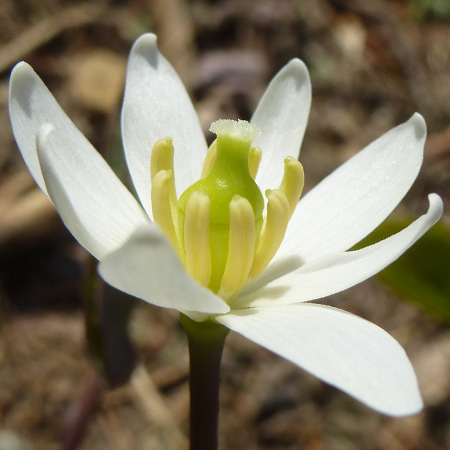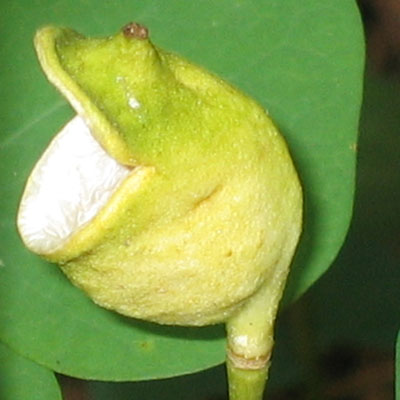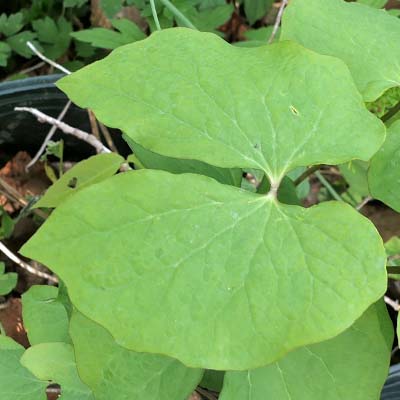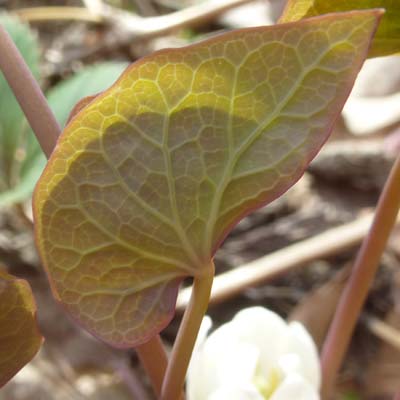Jeffersonia diphylla, Twinleaf, is a native perennial herbaceous plant that is rare in NJ. Twinleaf has short lived showy white flowers that bloom in early spring.
Flowers
The twinleaf flower grows singly on the top of a slender leafless stalk. The showy flower is about 1 inch across. It has 4 sepals that fall off early and usually 8 pure white petals. In the center is a large green ovary with a short stubby style topped by a whitish stigma. It has 8 stamens and the anthers are yellow. Unlike in most stamens, the anther is much longer than the filament. In the right photo below, is an early flower. The filament can barely be seen at the base of the anther. The plant can have several flowering stems. All the flower photos here are from mid-April.


Twinleaf releases it pollen in an unusual way. The anthers have several flaps that release from the bottom and the flaps are hinged at the top. Sometimes the flaps roll up and at the same time release pollen. The rolled up anther flaps can easily be seen in the 2 photos below. In the second photo, the arrow points to a flap that is partially rolled up


Here the anther flaps are hinged at the top, split from the bottom but splay upwards releasing pollen.

Red arrow points to the anther and green arrow to the filament.

Flower buds with sepals. Sepals, stems, and leaves are maroonish.

The flowers only open on warm sunny days and last only for 1 to 3 days. Afterwards they self-pollinate if they have not been already pollinated and shed their petals. This is referred to as facutatively autogamous meaning optional self-pollination. It appears that seed set is the same for self and cross pollinated flowers. The flowers provide no nectar but provide copious amounts of pollen for their pollinating insects.
Fruit
Fruit: The twinleaf fruit is a large capsule. It has a horizontal line that is apparent even in the ovary stage and the line does not go completely around the capsule. The capsule pops open along that line creating a hinged lid when the fruit is mature. The fruits may mature by June. The capsules tips downward spilling their shiny brown seeds. The seeds have elaiosomes and ants carry the seeds to their nests for the fat rich elaiosomes. This is called myrmecochory. The seed are not eaten and are discarded in the ant trash where they can germinate. Bloodroot and spring beauty also have seeds with elaiosomes. The twinleaf fruits before they are even ripe are frequently food for mice and other animals.



Leaves
The leaf is almost completely divided into 2 lobes that mirror each other, therefore, the name twinleaf. The leaves are on long stems that emerge from the roots. The leaf stems are short while flowering and fruiting but elongate to 1.5 ft as the fruit matures. Each twinleaf plant can have 4 to 8 leaves. The double lobed leaf can be 3 to 6 inches across. The immature leaves are short and reddish to maroon when the flowers start to bloom. They grow to 18 inches tall as the fruits mature. The leaves continue throughout the summer and begin to turn yellow only in October with the frost.
Twinleaf is not a spring ephemeral since the plant does not go underground early. As mentioned above, leaves are present till the fall.
Deer have been known to eat the leaves.




Plant, Habitat
The Twinleaf plant grows in the shade in deciduous woods in moderately moist soils. It grows to about 10 inches high and 12 inches wide.
The leaf and flower stalks grow directly from the underground rhizome.
It has a wide range in the east but in NJ it is critically imperiled (S1), 2024 and G5.
 There are only 2 species of the genus "Jeffersonia", this one and one in Japan. The genus 'Jeffersonia' was named after Thomas Jefferson by Benjamin Smith Barton, the "Father of American Botany" in 1792 for Jefferson's contributions in the study of nature.
This plant is still being grown and sold in the "Thomas Jefferson Center for Historic Plants" at Monticello in VA.
There are only 2 species of the genus "Jeffersonia", this one and one in Japan. The genus 'Jeffersonia' was named after Thomas Jefferson by Benjamin Smith Barton, the "Father of American Botany" in 1792 for Jefferson's contributions in the study of nature.
This plant is still being grown and sold in the "Thomas Jefferson Center for Historic Plants" at Monticello in VA.
Text by Millie Ling and all photos by Hubert & Millie Ling. Photos: all from cultivation, Central Jersey.
Additional information and References
Additional information / references:
- "Gardener News" article: "Flower For A Day"
- "Spring Wildflowers of the Northeast", Carol Gracie, pg 198-205.
- Minnesota Dept of Natuaral Resources, Rare Species Guide: https://www.dnr.state.mn.us/rsg/profile.html?action=elementDetail&selectedElement=PDBER05010
- Eye On Nature:Twinleaf–a President’s Wildflower https://eyeonnature.wordpress.com/2012/04/02/twinleaf-a-presidents-wildflower/
- The USDA database shows Jeffersonia diphylla distribution in the US and other information: https://plants.usda.gov/home/plantProfile?symbol=JEDI
- The Explorer at NatureServe shows twinleaf, Jeffersonia diphylla distribution and rarity in the US and other information: https://explorer.natureserve.org/Taxon/ELEMENT_GLOBAL.2.160325/Jeffersonia_diphylla
- NJ DEP: Dodds, Jill S. 2022. Jeffersonia diphylla Rare Plant Profile. New Jersey Department of Environmental Protection, State Parks, Forests & Historic Sites, State Forest Fire Service & Forestry, Office of Natural Lands Management, New Jersey Natural Heritage Program, Trenton, NJ. 16 pp.: https://www.nj.gov/dep/parksandforests/natural/heritage/docs/jeffersonia-diphylla-twinleaf.pdf